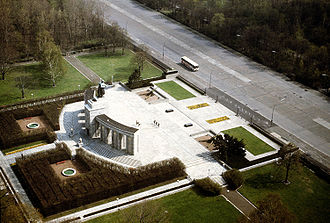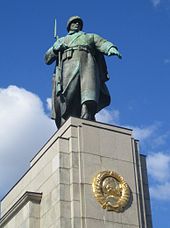Soviet Memorial (Tiergarten)
The Soviet War Memorial in the Tiergarten is located in the Great Tiergarten in Berlin 's Tiergarten district ( Mitte district ) on Strasse des 17. Juni . The facility was built in 1945 to honor the soldiers of the Red Army who died in World War II .
Soviet memorials in Berlin
After the end of World War II, the Red Army created four Soviet memorials in the urban area of Berlin. They were supposed to remember the Red Army soldiers who were killed , especially the 80,000 or so soldiers who died in the Battle of Berlin . These memorials are not only memorials to the victory, but also memorials in association with military cemeteries and thus Soviet war cemeteries in Germany . The central memorial is the large facility in Treptower Park ( Treptower Park ). In addition, the memorial in the Great Zoo, the memorial in the Schönholzer Heide ( Schönholzer Heide ) and the memorial in the Bucher Schlosspark ( Berlin-Buch ) were created. The latter two are located in the Pankow district .
Building history

The memorial was designed by the sculptors Lew Kerbel and Wladimir Zigal together with the architect Nikolai Sergijewski based on a resolution of the War Council of the 1st Belarusian Front and erected at the intersection of Siegesallee with what was then Charlottenburger Chaussee (today: Strasse des 17. Juni). It was built as a block across the Wilhelminian Siegesallee that existed at the time (built between 1895 and 1901). This memorial is the last on the battle path of the 1st Belarusian Front from Küstrin via Seelow to Berlin. On November 11, 1945, the memorial was inaugurated with a parade of the Allied troops .
The memorial was located on the territory of the British Sector of Berlin. However, the four-power status of Berlin allowed it to be guarded by Soviet soldiers. After the wall was built in 1961, it was cordoned off and secured by the British occupying forces. Until December 22, 1990 honor guards of the Soviet Army stood there . The system was then handed over to the city of Berlin. There are bilateral agreements between Germany and the Russian Federation , according to which Germany has undertaken to preserve these and other war cemeteries. Extensive repairs took place in the mid-1990s and 2014 in the run-up to the 70th anniversary of the end of the war. Among other things, the bronze sculpture of the Red Army soldier was re-anchored, the guns and tanks were completely refurbished and the inscriptions and emblems were newly gilded.
The victims
In the rear - landscaped - part of the complex are the graves of Soviet soldiers. Their exact number is not known, the figures range between 2000 and 2500 fallen Red Army soldiers. Soviet soldiers who died in the fighting for Berlin rest here in April and May 1945. There are no gravestones with the names of the deceased on the two large areas of grass behind the memorial. On the pillars of the memorial, names are written on the front and back.
The attachment

The center of the memorial consists of a row of pillars arched inwards towards the street with a central, larger pillar as a base for an eight-meter-high bronze statue. The sculpture shows a Red Army soldier with a rifle shouldered - an indication of the end of the war. The Russian inscription means: “Eternal glory to the heroes who fell for the freedom and independence of the Soviet Union in the fight against the fascist German invaders. 1941–1945. ”On the pillars there are texts that refer to the different branches of arms, as well as the names of fallen soldiers. The entrance to the memorial is flanked by two T-34/76 tanks and two cannons that were used in the Battle of Berlin . To the right and left of the main path are two sarcophagi with the names of fallen officers.
Allegedly, parts of the demolished Reich Chancellery are said to have served as building material.
See also
literature
- Helga Köpstein : The Soviet memorials in Berlin. Berlin 2006, ISBN 3-9811048-1-1 .
- Frank Schumann : Monuments of Liberation: Traces of the Red Army in Germany. In: New Life , 2020, ISBN 978-3-355-01890-6 .
Web links
- Entry in the Berlin State Monument List
- Tiergarten Memorial on the website of the Berlin Senate Department for Urban Development
Individual evidence
- ↑ a b See text on the board in the small building behind the memorial.
- ↑ Development of the crossing area Siegesallee / Charlottenburger Chaussee on the plan 4233 from the years 1936/1937, 1939, 1950 and 1955 ( Memento from November 16, 2016 in the Internet Archive )
- ↑ Uwe Aulich: Soviet memorial in Berlin-Tiergarten: New paint for the tanks . In: Berliner Zeitung , October 22, 2014, accessed January 26, 2017
- ↑ See text on the board on the grille of the memorial. File: Berlin-soviet-memorial-tiergarten-plaque-tomb.JPG
- ↑ Sven Felix Kellerhoff : Traces of the stones . In: Berliner Morgenpost , August 13, 2006 (inaccessible weblink)
Coordinates: 52 ° 31 ′ 0 ″ N , 13 ° 22 ′ 20 ″ E




